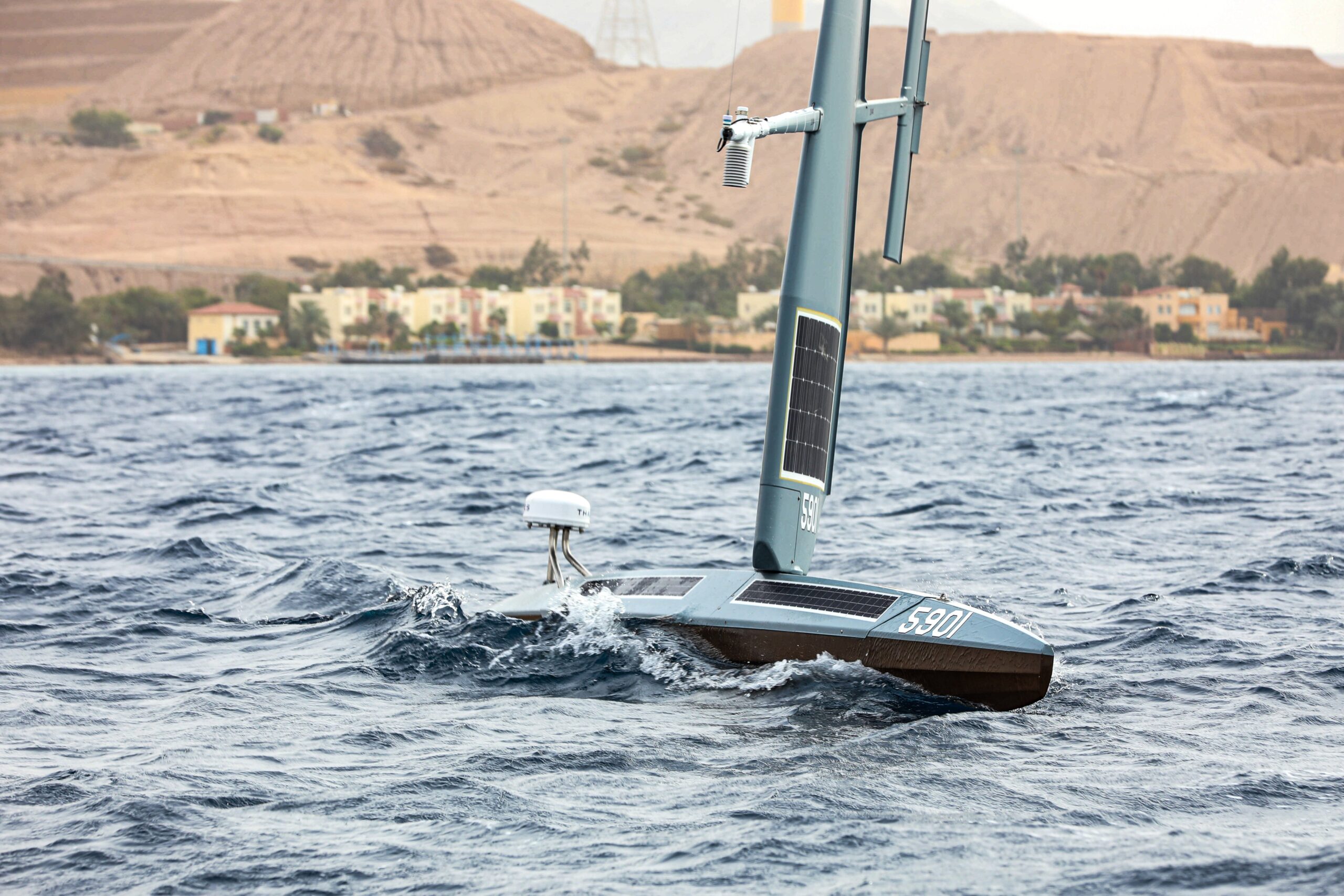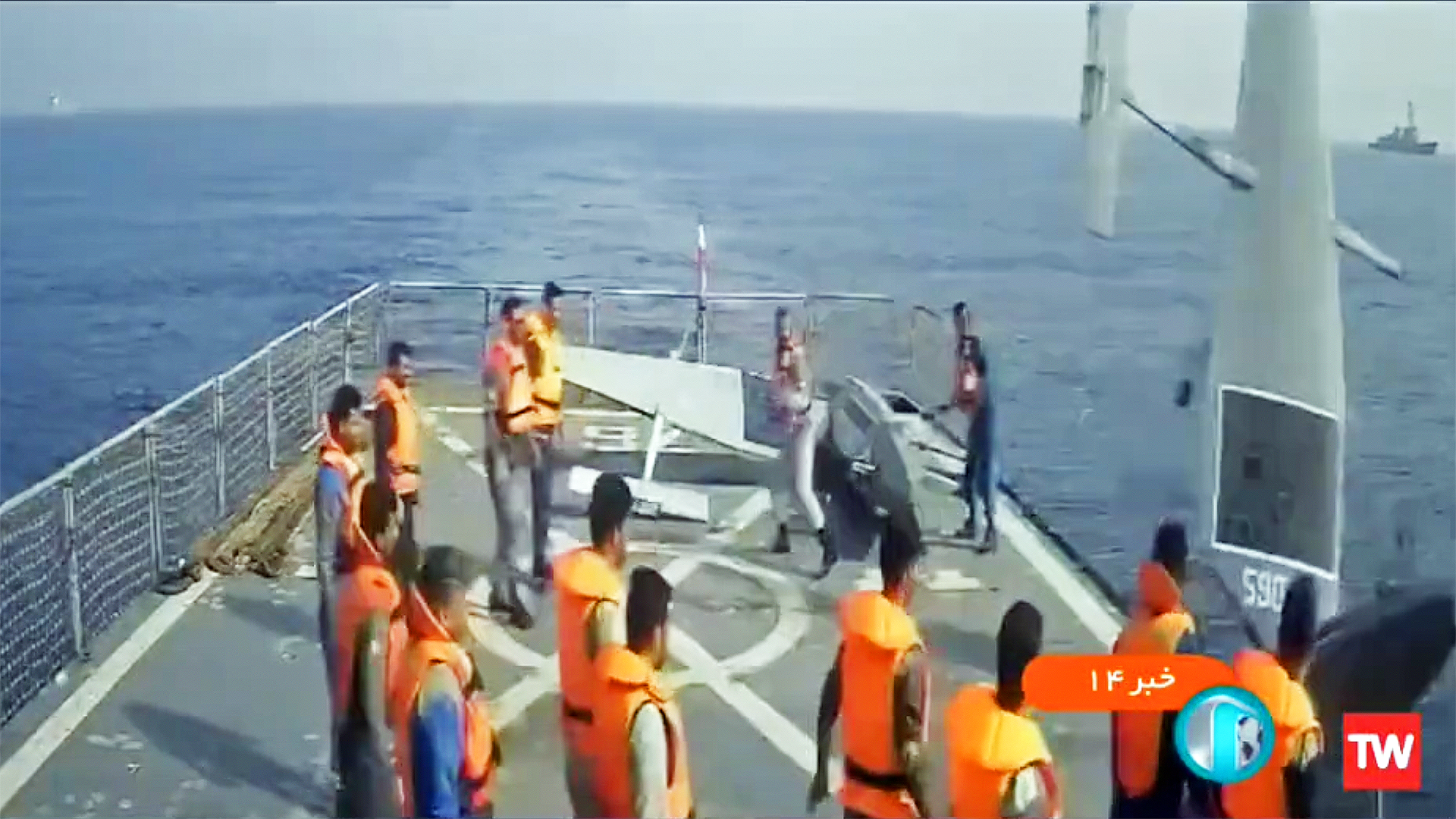Just days after the Islamic Revolutionary Guard Corps Navy attempted to capture a U.S. Navy Saildrone Explorer unmanned surface vessel in the Persian Gulf, the Iranian Navy has now reportedly done the same with two more of the systems, this time in the Red Sea. The seizure was said to have taken place on Thursday with Iran eventually releasing the unmanned sailboats back into U.S. Navy custody on Friday, but the reasoning as to why it occurred in the first place remains murky.
Iranian state television was the first to report the capture, using footage taken from the deck of the Iranian Navy’s Jamaran destroyer that showed crewmembers pushing the two Sailrone unmanned surface vessels (USVs) belonging to the U.S. Navy’s 5th Fleet off the ship and back into the water. Speaking to the Associated Press on the condition of anonymity, a U.S. defense official explained to the outlet that two U.S. Navy destroyers transiting the Red Sea along with unspecified Navy helicopters responded to the incident and communicated with the Jamaran destroyer over the radio until the USVs were relinquished. The War Zone has reached out to the 5th Fleet and the U.S. Naval Forces Central Command (5th Fleet/NAVCENT) for additional information but has yet to hear back.
During the Iranian state-affiliated broadcast, it was revealed that Iran had justified the capture by claiming that the Saildrone allegedly endangered safe navigation in the area. The Associated Press provided quotes with translated dialogue from the Iranian program, which interestingly claimed that “several unmanned spying vessels” were “abandoned in the international maritime routes.”
“After two warnings to an American destroyer to prevent possible incidents, Jamaran seized the two vessels,” the Iranian state TV broadcast claimed. “After securing the international shipping waterway, the Naval Squadron No. 84 released the vessels in a safe area.”
Similar reasoning was used to explain the Islamic Revolutionary Guard Corps Navy’s (IRGCN) actions after the initial seizure this Tuesday. However, reports now coming out of Washington are suggesting that may not have been the case.
Phil Stewart, a military and intelligence correspondent for Reuters, shared a post on Twitter claiming that an unidentified U.S. official had told him that the Iranian Navy had the pair of captured Saildrones on the Jamaran’s deck covered in tarps to start. The Iranian destroyer’s crew then reportedly proceeded to deny having any U.S. government property on board before eventually conceding and releasing the USVs back into the sea.
Any statement received from the 5th Fleet/NAVCENT will likely clarify the crux of these conflicting reports, and The War Zone will be sure to provide it in an update.
The entire situation is particularly strange for a number of reasons beyond the he-said, she-said claims that have begun circulating. For one, the IRGCN is the entity that has been at the forefront of this kind of harassment in recent years as opposed to the Iranian Navy, having most recently seized a South Korean-flagged tanker ship carrying 7,200 tons of “oil-based chemicals” in the strategic Strait of Hormuz.
It is also worth mentioning that the Red Sea is a relatively notable area for all of this to have gone down. The body of water has been the site of ship attacks in recent years as the complex web of tensions between the United States, Iran, Saudi Arabia, Yemen’s Houthi rebels, and Israel continue to mount.
Additionally, Iranian state TV calling the Saildrone a “spy vessel” and insisting that “several” of the type had been “abandoned” in the area is a bit of a stretch. While Saildrone certainly does harbor intelligence-gathering capabilities, the U.S. Navy itself describes the USV as being U.S. government property equipped with sensors, radars, and cameras made up of commercially available technology for navigation and data collection, meaning the drone vessels don’t carry with them highly sensitive information or electronics. Thus, Saildrone could be described as a spy vessel, yes, but it’s overall on the lower end of the surveillance and awareness technology spectrum.

On top of that, the 5th Fleet, headquartered in Bahrain, oversees the unmanned Task Force 59, which first launched a solar-powered Saildrone in the Gulf of Aqaba in 2021 at the northern end of the Red Sea to establish better maritime domain awareness. While it isn’t clear how many Saildrones have been deployed to the area since then (the tweet below suggests at least three) it isn’t likely that the USVs would be “abandoned” by the task force as the Iranian TV broadcast insisted. By their very nature, they are unmanned. As such, unless they were visibly disabled, Iran would not know if they were actually abandoned or not.
As noted in The War Zone’s coverage of Tuesday’s incident, unmanned vessels like Saildrone certainly present vulnerabilities to capture based solely on the fact that no human operators are present onboard to physically prevent seizures from happening. This thought is further supported because no lives are at risk, making it so the barrier to such actions is markedly lower.
When asked by reporters at a recent Pentagon briefing about the threat of being stolen that unmanned vessels face, Air Force Brig. Gen. Pat Ryder responded as such:
“So I’m not going to, you know, speculate on the hypothetical in terms of how often this could happen,” said Ryder. “Clearly, Fifth Fleet has it well in hand in terms of patrolling the waterways there and maintaining, you know, situational awareness in terms of their capabilities and assets in the region. And again, as was evidenced by the USS Thunderbolt, the ability to respond quickly should something like that happen again in the future, which hopefully it will not.”
Earlier this week The War Zone insisted that Tuesday’s capture of the unmanned Saildrone would only be a sign of what’s to come, and the Iranian Navy evidently wasted no time in proving that point.
Update 9/2 4:30 p.m. EST —
The U.S. 5th Fleet/Naval Forces Central Command has now issued a press release about this incident that includes new details in regard to the U.S. Navy’s response. The details are as follows:
“The unmanned surface vessels were unarmed and taking unclassified photos of the surrounding environment while loitering in an assigned patrol area at least four nautical miles from the nearest maritime traffic lane. The vessels posed no risk to naval traffic and had been operating in the general vicinity of the Southern Red Sea for more than 200 consecutive days without incident.”
“At around 2 p.m. (local time) on Sept. 1, U.S. 5th Fleet detected the Iranian ship approaching both unmanned vessels and removing them from the water. U.S. Navy guided-missile destroyers USS Nitze (DDG 94) and USS Delbert D. Black (DDG 119) were operating nearby and immediately responded. Nitze and Delbert D. Black also each launched an MH-60R Sea Hawk from Helicopter Maritime Strike Squadron 48.”
Contact the author: Emma@thewarzone.com
